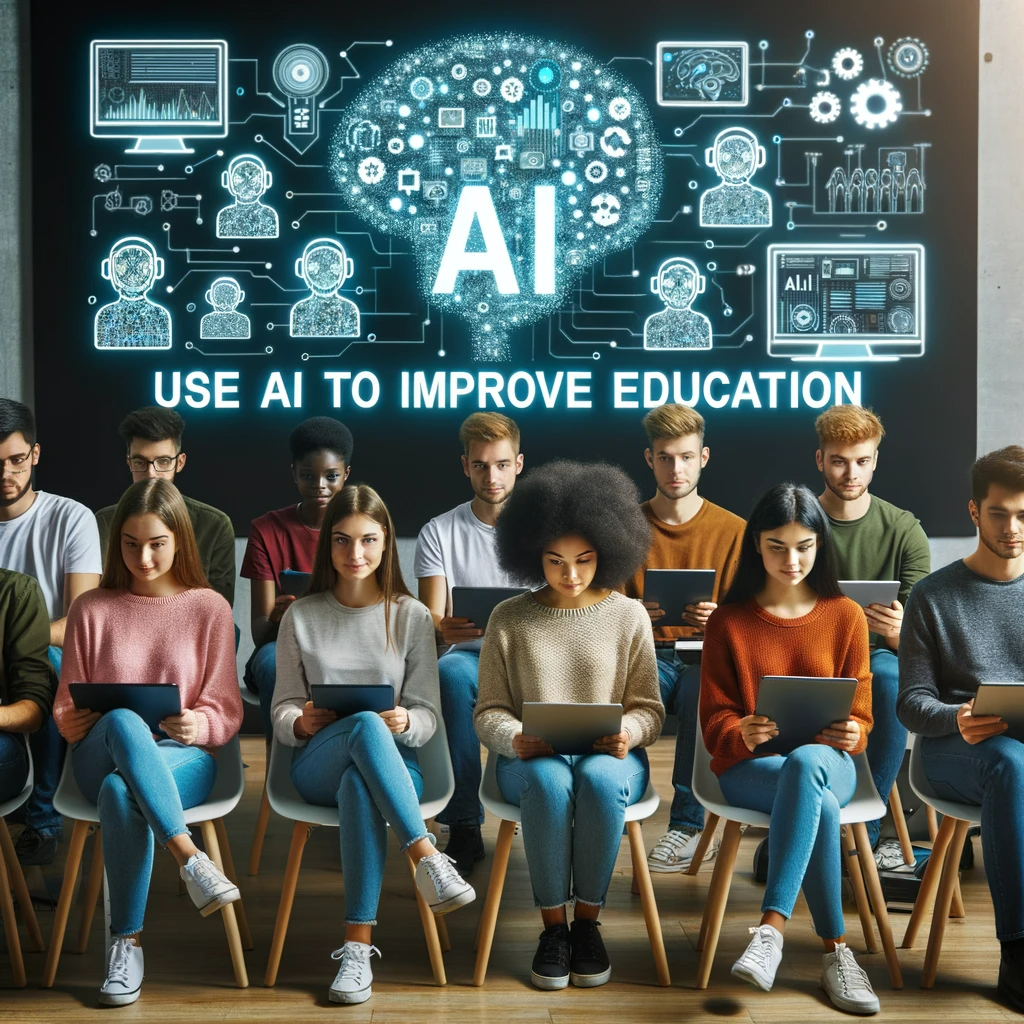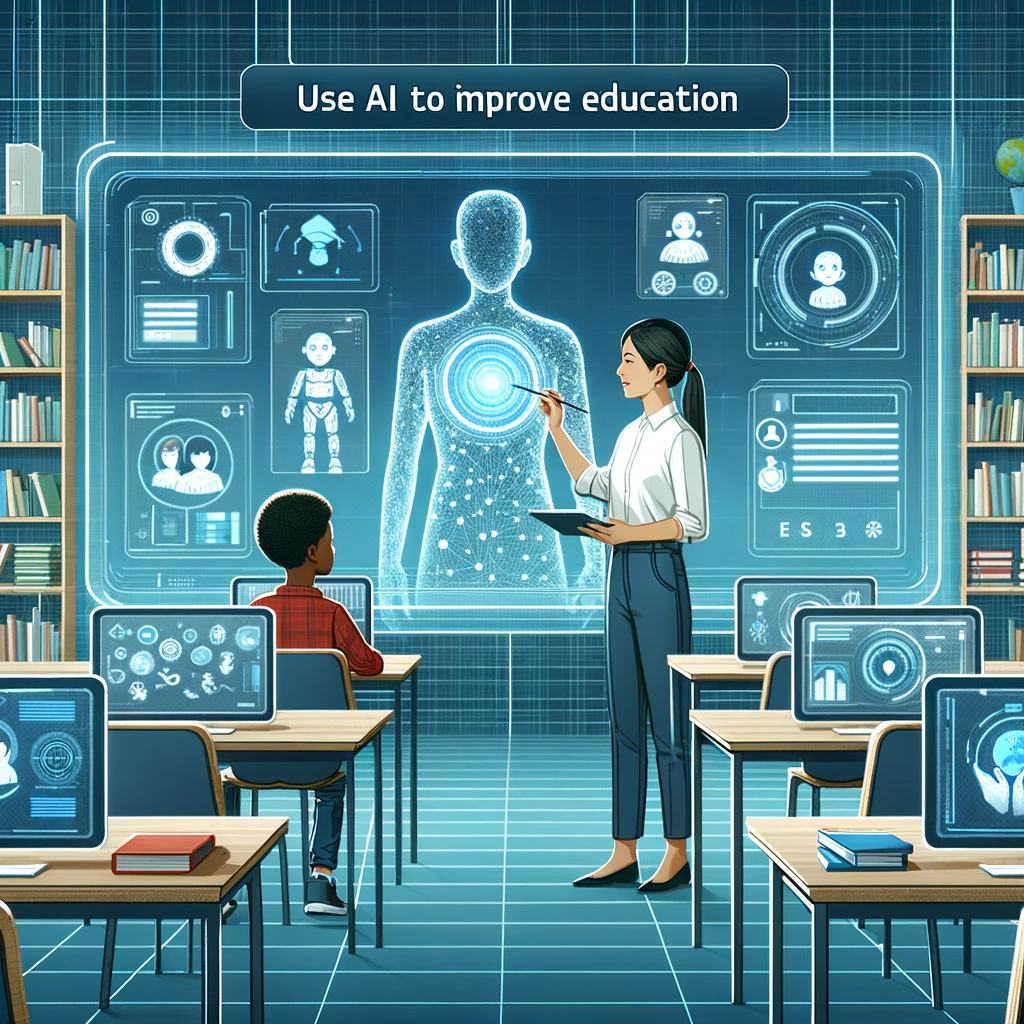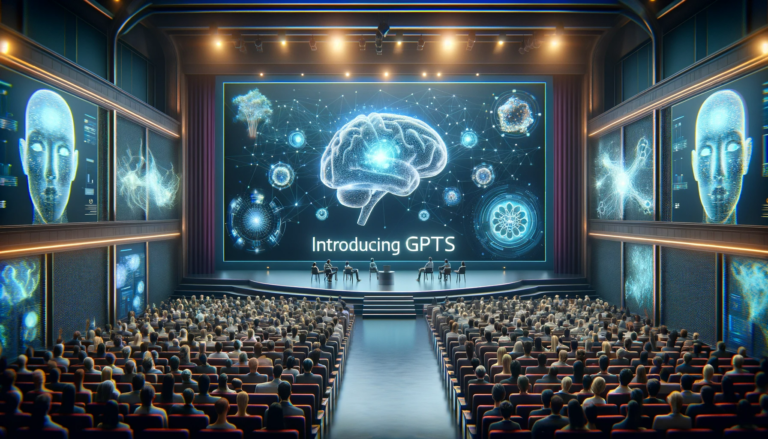
In today’s rapidly evolving world, education is constantly challenged to keep up with advancements in technology. AI, or artificial intelligence, has emerged as a powerful tool that can revolutionize the way we learn and teach.
By harnessing the capabilities of AI, educators can personalize instruction, analyze student data, and create interactive learning experiences that cater to the individual needs of each student. In this article, we will explore the various ways in which AI can be utilized to enhance education, providing an insight into a brighter and more engaging future of learning. So, let’s delve into the exciting possibilities of using AI to improve education!
Use AI To Improve Education

Enhanced Personalized Learning
AI technology has revolutionized the field of education by offering enhanced personalized learning experiences for students. Through the use of AI-powered algorithms, educators can gather and analyze vast amounts of data about individual students’ learning styles, preferences, and strengths. This allows for the creation of tailored learning paths that cater to each student’s unique needs. With AI, students can receive personalized recommendations for relevant learning materials, adaptive quizzes, and interactive activities, ensuring that they are challenged at their own pace and provided with the resources they need to succeed.
Efficient Administrative Tasks
Another significant benefit of implementing AI in education is the automation of labor-intensive and time-consuming administrative tasks. With the help of AI tools, schools and universities can streamline student enrollment processes, automate attendance tracking, and manage grading and assessments. Automated grading systems can evaluate multiple-choice exams and provide instant feedback to students, freeing up valuable time for educators to focus on more impactful tasks, such as providing individualized instruction and mentoring.
Improved Accessibility
AI technology has the potential to bridge the gap and improve accessibility in education for learners with different abilities and needs. Assistive technologies powered by AI can support students with disabilities by providing real-time captioning, text-to-speech capabilities, and alternative input methods. AI-driven translation tools can facilitate language learning for non-native speakers, making education more inclusive and culturally diverse. Furthermore, AI can enable content customization and adaptation, allowing educators to provide tailored resources to students with varying learning preferences or sensory impairments.
Real-Time Feedback and Assessment
One of the most valuable applications of AI in education is its ability to provide real-time feedback and assessment to students. Through automated feedback systems, AI can analyze and evaluate student assignments promptly, providing detailed suggestions for improvement. Instant grading mechanisms enable students to receive immediate feedback on their performance, enhancing their understanding of subject matter and promoting self-directed learning. Additionally, AI-powered predictive analytics can identify potential issues or gaps in knowledge, allowing educators to intervene effectively and provide targeted support when needed.
Enhanced Student Engagement
AI technologies have the potential to revolutionize student engagement by making learning more interactive, dynamic, and exciting. Smart content creation and delivery systems leverage AI algorithms to create personalized and engaging learning experiences for students. By adapting content based on individual preferences and learning styles, AI helps students stay motivated and eager to learn. Gamification and game-based learning platforms integrate AI to transform traditional learning into interactive and immersive experiences, fostering a sense of enjoyment and competition among students. Virtual assistants and chatbots, powered by AI, can also provide students with instant support and guidance, creating a supportive learning environment.
Implementing AI in the Classroom
Identifying Areas of Application

Before implementing AI in the classroom, it is essential to identify the specific areas where AI can make a meaningful impact. Educators and school administrators should assess their current challenges and objectives to determine where AI technology can be most beneficial. This may include evaluating existing teaching methods, administrative processes, and student performance indicators. By identifying areas of application, educators can effectively integrate AI tools and strategies where they will have the greatest potential to enhance teaching and learning outcomes.
Selecting Suitable AI Tools
Once the areas of application have been identified, it is crucial to select suitable AI tools that align with the educational objectives and requirements. There is a wide range of AI-powered tools and platforms available, each designed to address specific educational needs. Educators should evaluate different options, considering factors such as their ease of use, compatibility with existing systems, scalability, and the level of customization they offer. Pilot testing and gathering feedback from teachers and students can help determine the most appropriate AI tools for the classroom.
Integrating AI with Existing Systems
To ensure a seamless integration of AI technology in the classroom, it is essential to consider how it will interact with existing systems and processes. AI tools should be compatible with the school’s learning management systems, student information systems, and other educational technology platforms. This integration allows for the seamless transfer of data between systems, enabling educators to access comprehensive student profiles and leverage AI insights to inform their teaching practices. Collaborating with IT departments and conducting thorough testing and training can facilitate a successful integration of AI in the school environment.
Teacher Training and Support
Effective implementation of AI in the classroom requires adequate training and support for educators. Teachers need to understand how to use AI tools effectively, interpret and analyze AI-generated data, and integrate AI-based strategies into their teaching practices. Professional development programs, workshops, and ongoing support from AI experts can help teachers overcome any initial challenges and equip them with the necessary skills to harness the full potential of AI. Collaboration and knowledge sharing between educators can facilitate the exchange of best practices and innovative ways to incorporate AI into teaching pedagogies.
Using AI for Personalized Learning
Adaptive Learning Platforms
Adaptive learning platforms powered by AI are revolutionizing the way education is delivered. These platforms utilize AI algorithms to assess individual student performance, analyze learning patterns, and provide personalized recommendations for content and activities. By adapting to each student’s needs and progress, adaptive learning platforms ensure that students receive tailored instruction that maximizes their learning outcomes. Whether it’s adapting the difficulty level of quizzes, providing additional resources for struggling students, or challenging advanced learners with more complex tasks, AI-driven adaptive learning platforms offer a personalized learning experience for every student.
Intelligent Tutoring Systems
Intelligent tutoring systems are AI-powered tools that provide individualized instruction and support to students. By leveraging algorithms and machine learning, these systems can identify knowledge gaps, provide targeted feedback, and offer remedial resources to help students succeed academically. Intelligent tutoring systems can simulate one-on-one tutoring interactions, making learning more engaging, interactive, and effective. These systems can be particularly valuable in subjects such as mathematics, where personalized guidance and practice are crucial for building a strong foundation.
Virtual Reality and Augmented Reality
Virtual reality (VR) and augmented reality (AR) technologies are transforming the way students learn by creating immersive and interactive experiences. AI plays a significant role in enhancing these technologies by personalizing the learning content and providing real-time feedback. With VR and AR, students can explore historical landmarks, perform virtual science experiments, and engage in simulations that simulate real-world scenarios. AI algorithms can customize these experiences based on individual student preferences and adapt the difficulty level to ensure optimal engagement and learning outcomes.
Natural Language Processing
Natural language processing (NLP) is a subfield of AI that focuses on understanding and processing human language. In education, NLP enables AI-powered tools to analyze and interpret written or spoken language, facilitating communication and understanding between students and machines. NLP-based applications can include intelligent chatbots that provide instant feedback and assistance, virtual language tutors that evaluate pronunciation and grammar, and automated essay grading systems that assess the quality of student writing. By leveraging NLP, educators can create more interactive and responsive learning environments that cater to individual student needs.
Automating Administrative Tasks
Automated Grading and Assessment
AI technology has made significant strides in automating grading and assessment processes, saving educators valuable time and effort. Automated grading tools can analyze multiple-choice questions and essays, providing instant feedback and evaluation. By utilizing AI algorithms, these tools can assess student work for parameters such as grammar, spelling, coherence, and relevance to the topic. Automated grading not only accelerates the assessment process but also allows for the collection of valuable data that can be used to gain insights into student performance and identify areas for improvement.
Streamlining Student Enrollment
AI can streamline and simplify the student enrollment process by automating several tasks. From online application submissions to document verification and enrollment management, AI-powered tools can expedite the administrative processes involved in admitting new students. By utilizing natural language processing and machine learning, AI tools can extract relevant information from forms, validate documents, and even suggest potential courses or programs based on student preferences and requirements. This automation reduces manual paperwork, eliminates errors, and enhances the overall efficiency of student enrollment.
Attendance Monitoring
Monitoring and tracking student attendance is a crucial administrative task, particularly in larger educational institutions. AI technology offers automated attendance monitoring systems that use facial recognition or biometric data to track student presence and absence. These systems eliminate the need for manual attendance-taking, reducing administrative effort and ensuring accurate records. Furthermore, with real-time data on attendance, educators can identify patterns of attendance and intervene when necessary, promoting regular attendance and timely intervention for students at risk of falling behind.
Smart Scheduling
AI technology can optimize scheduling processes in educational institutions, making it easier to manage timetables, allocate resources, and coordinate classes and events. Smart scheduling tools powered by AI algorithms can consider various parameters such as classroom availability, teacher expertise, student preferences, and course requirements to generate efficient and conflict-free schedules. By automating the scheduling process, AI saves time and reduces scheduling conflicts, allowing educators to focus on delivering quality instruction rather than dealing with logistical challenges.
Improving Accessibility with AI
Assistive Technologies for Special Needs
AI-powered assistive technologies offer tremendous benefits for students with special needs and disabilities. These technologies can provide real-time assistance and support for individuals with visual impairments, hearing impairments, cognitive disabilities, or mobility challenges. Text-to-speech tools, screen readers, and speech recognition systems enable students with visual impairments to access written content and participate in online discussions. AI-driven sign language interpretation tools can bridge communication gaps for students with hearing impairments. Through AI, educational institutions can provide an inclusive and accessible learning environment for students of all abilities.
Translation and Language Learning
AI can break down language barriers by offering translation and language learning support. AI-powered translation tools can facilitate communication and understanding among students from different language backgrounds, promoting cultural diversity and collaboration. These tools can also aid in language learning by providing instant translations, vocabulary suggestions, and grammar tips. AI-driven language learning platforms can customize lessons based on individual needs, offering interactive exercises and pronunciation feedback. By leveraging AI for translation and language learning, educational institutions can expand their global reach and provide comprehensive support to students learning a second language.
Content Customization and Adaptation
AI technology enables content customization and adaptation to suit students’ individual learning preferences and needs. Intelligent algorithms can analyze students’ learning patterns, performance data, and interests to curate personalized learning experiences. This customization can include adapting reading materials to different reading levels, providing additional resources for struggling students, or offering advanced content for high achievers. By tailoring content according to individual requirements, educators can create engaging and inclusive learning environments that motivate students and maximize their learning outcomes.
Universal Design for Learning
AI can support the principles of Universal Design for Learning (UDL) by providing accessible and flexible learning experiences. UDL aims to remove barriers to learning and provide multiple means of representation, engagement, and action and expression. AI-driven tools and platforms can offer diverse formats for content delivery, such as visual, auditory, or kinesthetic resources, allowing students to engage with the material in their preferred learning style. Furthermore, AI can provide adaptive feedback and alternative assessments, ensuring that students with different learning profiles have equal opportunities for success.
Providing Real-Time Feedback and Assessment
Automated Feedback on Assignments
AI technology can provide automated feedback on student assignments, enhancing the learning experience by offering timely and precise guidance. Automated feedback systems can analyze student work, identify errors, and suggest improvements, alleviating the burden on teachers in providing individualized feedback. By leveraging AI-powered feedback tools, educators can focus on higher-level tasks such as mentoring and facilitating deeper learning, while students receive immediate, actionable feedback that helps them improve their understanding and performance.
Instant Grading and Performance Tracking
Gone are the days of waiting days or weeks for grades to be returned. AI technology enables instant grading and performance tracking, providing students with immediate feedback on their work and progress. AI-powered grading systems can evaluate multiple-choice exams, essays, and other assignments, providing accurate and consistent results. Instant grading not only benefits students by allowing them to track their performance in real-time but also enables educators to gain valuable insights into areas where students may be struggling or excelling, guiding their instructional strategies accordingly.
Data-Driven Insights for Intervention
AI technology can generate data-driven insights that help educators make informed decisions and interventions to support student learning. By analyzing large volumes of data, AI algorithms can identify patterns and trends, highlighting areas where students may need additional support or intervention. Educators can use these insights to personalize instruction, optimize teaching methods, or provide targeted resources to address specific student needs. Data-driven insights can lead to more effective interventions and promote student success by addressing challenges in a proactive and evidence-based manner.
Predictive Analytics for Student Success
AI-powered predictive analytics can forecast student performance and provide early warnings for academic risks. By analyzing historical data, demographics, attendance records, and other relevant factors, AI algorithms can identify students who may be at risk of falling behind or failing. This early identification allows educators to intervene in a timely manner, providing necessary support and resources before academic challenges escalate. Predictive analytics can be a game-changer in promoting student success, enabling educators to take proactive measures to ensure each student’s learning journey is a successful one.
Enhancing Student Engagement
Smart Content Creation and Delivery
AI technology is transforming content creation and delivery in education, enabling educators to create engaging and interactive learning materials. By leveraging AI algorithms, educators can design adaptive content that adapts to students’ abilities, progress, and interests. From interactive videos and simulations to gamified quizzes and virtual experiments, AI-driven content creates an immersive and personalized learning experience. Smart content delivery platforms can track student engagement and provide real-time feedback, ensuring that students stay motivated and actively involved in their learning.
Gamification and Game-Based Learning
Gamification and game-based learning leverage AI to make education more enjoyable and engaging for students. By incorporating game mechanics, such as points, badges, leaderboards, and virtual rewards, into the learning process, AI-powered platforms foster a sense of competition and motivation among students. Gamified learning experiences can transform complex or mundane topics into engaging challenges, capturing students’ attention and encouraging them to actively participate in their education. AI algorithms in gamified learning platforms can adapt the difficulty level of activities, ensuring that students are appropriately challenged and motivated to continue learning.
Virtual Assistants and Chatbots
AI-driven virtual assistants and chatbots are transforming the way students access information and seek support. These intelligent tools can provide personalized assistance, answering questions, and guiding students in real-time. Virtual assistants can offer explanations, provide examples, and address misconceptions, simulating real-time interactions with educators. Chatbots can assist with administrative inquiries, provide study tips, or offer recommendations for additional resources. By leveraging AI, virtual assistants and chatbots enhance student autonomy, optimize time management, and create a supportive learning environment where students can access immediate help.
Collaborative Learning Platforms
AI technology enables collaborative learning platforms that foster interaction and collaboration among students. These platforms provide opportunities for students to engage in group projects, discussions, and knowledge sharing. AI algorithms can facilitate group formation based on shared interests or complementary skills, enhancing peer learning and collaboration. Collaborative learning platforms also enable students to receive peer feedback, promoting critical thinking, reflection, and a deeper understanding of the subject matter. AI-powered collaborative learning platforms empower students to learn from each other and develop essential collaboration skills.
Ethical Considerations in AI Education
Privacy and Data Security
As AI becomes more integrated into education, issues of privacy and data security arise. Educational institutions must ensure that student data is protected and used ethically. AI tools and platforms should adhere to strict privacy regulations and employ robust security measures to safeguard sensitive information. It is vital for educators and administrators to be transparent about the data collected and to obtain appropriate consent from students and parents. By prioritizing privacy and data security, educational institutions can harness the benefits of AI while maintaining trust and confidentiality.
Algorithmic Bias and Fairness
One ethical consideration in AI education is the potential for algorithmic bias and unfairness. AI algorithms can be trained on biased data, leading to biased outcomes and perpetuating existing inequalities. It is crucial to ensure that AI tools used in education consider factors such as race, gender, and socioeconomic status and mitigate any potential bias. Regular auditing and testing of AI systems can identify biases and ensure that the algorithms are promoting fairness and equity. Educators and developers must collaborate to address biases and promote equal access to education for all students.
Transparency and Explainability
AI algorithms can often be complex and opaque, making it challenging to understand how they arrive at their decisions. In an educational context, transparency and explainability are essential to build trust and ensure that students and educators understand the reasoning behind AI-generated recommendations or assessments. Developers should strive to design AI tools that are explainable and understandable, providing insights into how the algorithms work and how they influence the learning process. Transparent AI promotes accountability, fosters critical thinking, and empowers students to make informed decisions.
Equity and Inclusion
While AI technology has the potential to enhance educational equity and inclusion, there is a risk of exacerbating existing inequalities. It is essential to ensure that AI tools are accessible to all students, regardless of their socioeconomic status, geographic location, or learning abilities. Educational institutions should invest in bridging the digital divide and providing access to technology for all students. Additionally, the design of AI algorithms should consider the diverse needs and backgrounds of students, fostering an inclusive learning environment where every student has an equal opportunity to succeed.
Challenges in Implementing AI in Education
Cost and Resource Constraints
Implementing AI in education can present significant challenges due to cost and resource constraints. Developing and integrating AI tools often require substantial investments in infrastructure, software, and training. Many schools and educational institutions may lack the financial resources or technical expertise needed to adopt AI technology fully. It is crucial for policymakers and educational leaders to explore funding opportunities and invest in capacity building to overcome these challenges and ensure that AI benefits are accessible to all students, regardless of socioeconomic limitations.
Integration with Traditional Teaching Methods
Successfully integrating AI into traditional teaching methods can be a complex task. Educators are often accustomed to traditional instructional approaches and may be hesitant or resistant to adopt AI technology. It is essential to provide teachers with training, professional development, and ongoing support to build their confidence and understanding of AI’s potential in education. Collaboration between AI experts and educators can help bridge the gap between technology and pedagogy, promoting effective integration and enhancing teaching practices.
Teacher-Student Relationship
One concern that arises with the implementation of AI in education is the potential impact on the teacher-student relationship. AI tools should be designed to complement and augment human instruction rather than replace educators. It is vital to strike a balance between AI-driven personalized learning and the essential role of teachers in facilitating meaningful interactions, mentoring, and providing emotional support. By positioning AI as a supportive tool rather than a replacement, educators can leverage the benefits of AI while maintaining the critical connection between teachers and students.
Digital Divide and Access to Technology
The digital divide remains a significant challenge in implementing AI in education. While AI has the potential to enhance learning outcomes, students who lack access to technology or stable internet connections may be left behind. To ensure equitable access to AI-driven education, educational institutions must work towards bridging the digital divide. This includes providing devices and internet connectivity to underserved communities, implementing technology infrastructure in schools, and promoting digital literacy for both students and educators. By addressing these challenges, educational institutions can foster equal opportunities and prevent the exacerbation of educational inequalities.
Future Outlook of AI in Education
Personalized Learning at Scale
The future of AI in education holds the promise of personalized learning at scale. As AI algorithms become more sophisticated and data collection continues to grow, educators can leverage AI to provide personalized learning experiences to a larger number of students. AI-powered adaptive learning platforms, virtual tutors, and content recommendation systems will enable students to receive tailored instruction and resources, regardless of class size or the individual teacher’s capacity. Personalized learning at scale has the potential to revolutionize education, ensuring that each student’s unique needs and learning preferences are met.
Adaptive Assessment and Credentialing
AI technology will also play a significant role in adaptive assessment and credentialing. Traditional assessments often rely on standardized tests and external evaluations, providing limited insights into students’ true abilities and potential. AI-powered adaptive assessments will enable educators to evaluate students’ progress in a more comprehensive and dynamic manner. These assessments will adapt to individual students’ strengths, weaknesses, and learning patterns, providing a more accurate representation of their skills and knowledge. Additionally, AI algorithms can analyze patterns in student performance to generate micro-credentials and badges that recognize specific competencies and accomplishments.
Emerging Technologies and Innovations
The future of AI in education will be driven by emerging technologies and innovations. As technologies such as virtual reality, augmented reality, and natural language processing continue to evolve, educational experiences will become more immersive, interactive, and personalized. Virtual reality simulations will allow students to explore historical events, conduct science experiments, and travel to distant places, enhancing their understanding and engagement. Natural language processing will enable AI-powered virtual tutors and chatbots to have more sophisticated conversations, providing support and guidance that closely resembles human interaction. As these technologies advance, AI will revolutionize the way education is delivered and experienced.
Collaboration between Humans and AI
The future of AI in education will be characterized by collaboration between humans and AI. While AI technology has the potential to augment teaching and learning, it cannot replace the unique skills and qualities of educators. The critical thinking, empathy, and creativity that teachers bring to the classroom are irreplaceable. AI will support educators by providing personalized insights, automating administrative tasks, and delivering content tailored to individual needs. By working together, educators and AI can create a learning environment that fosters critical thinking, creativity, and innovation, preparing students for the challenges and opportunities of the future.
In conclusion, AI offers numerous benefits in education, ranging from enhanced personalized learning to efficient administrative tasks. By implementing AI in the classroom, educators can identify areas of application, select suitable AI tools, integrate them with existing systems, and provide teacher training and support. AI can be used for personalized learning through adaptive learning platforms, intelligent tutoring systems, virtual reality, and natural language processing. It can also automate administrative tasks such as grading, enrollment, attendance monitoring, and scheduling. AI improves accessibility through assistive technologies, translation, content customization, and universal design for learning. Real-time feedback and assessment, as well as enhanced student engagement, are made possible through automated feedback, instant grading, and collaborative learning platforms. However, ethical considerations should guide the implementation of AI, addressing privacy, algorithmic bias, transparency, and equity. Challenges such as cost, integration, teacher-student relationships, and the digital divide must also be taken into account. Looking ahead, AI will continue to drive personalized learning, adaptive assessment, and emerging technologies, promoting collaboration between humans and AI in the field of education.






